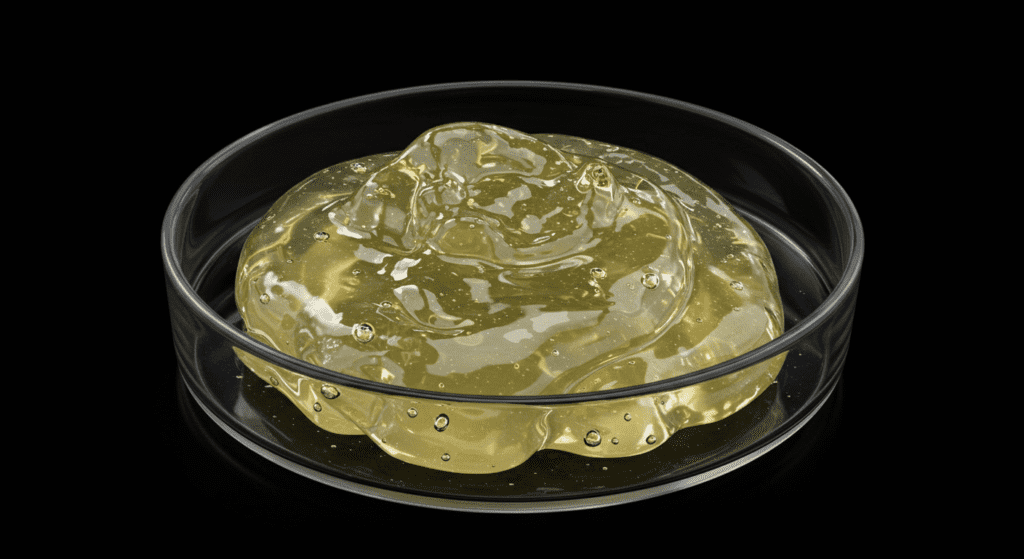
Soluble wax refers to wax materials that can completely dissolve in specific liquids. These waxes fall into two main categories: water-soluble waxes (like polyethylene glycols and PEG fatty acid esters) that dissolve in water, and organic solvent-soluble waxes (including natural animal, plant, and mineral waxes as well as synthetic varieties) that dissolve in chemicals like alcohol or benzene.
When something dissolves, tiny pieces of it mix evenly with another substance. This happens because of how molecules interact with each other. The rule “like dissolves like” explains this well – substances with similar chemical structures tend to dissolve in each other.
For waxes to dissolve, their molecules must be able to mix with the solvent’s molecules.
Soluble waxes come in two main types based on what they dissolve in: water-soluble waxes and organic solvent-soluble waxes.
Polyethylene glycols (PEGs) are the most common water-soluble waxes. They’re made by linking many ethylene glycol molecules together. The longer the chain, the more solid and wax-like they become.
PEGs with molecular weights between 1,000 and 2,000 have wax-like properties. They dissolve easily in water and feel waxy to the touch.
PEG fatty acid esters are nonionic surfactants derived from the chemical reaction between Polyethylene Glycols and fatty acids.
While the PEG segment imparts hydrophilicity, the fatty acid segment contributes lipophilicity. The overall solubility in water is therefore dependent on the balance between these two parts, often quantified by the Hydrophile-Lipophile Balance (HLB) value.
| Wax Type | Origin | Key Chemical Components | Typical Melting Point (°C) | Common Organic Solvents | Key Properties/Applications |
|---|---|---|---|---|---|
| Beeswax | Animal (Honeybee) | Esters (e.g., myricyl palmitate), free fatty acids, hydrocarbons, polyesters, free alcohols | 62-64 | Oils, warm alcohol, chloroform, ether, benzene, carbon disulfide | Cosmetics (emollient, structurant), candles, pharmaceuticals, polishes |
| Carnauba Wax | Plant (Copernicia cerifera palm) | Esters (aliphatic, hydroxycinnamic acid diesters), ω-hydroxycarboxylic acids, fatty alcohols | 82-86 | Hot ethyl acetate, hot xylene | High gloss polishes (car, shoe), coatings, cosmetics (hardener), food additive |
| Candelilla Wax | Plant (Euphorbia species) | Hydrocarbons (>50%), esters (~35%), free fatty acids, alcohols, resins | 68-73 | Acetone, chloroform, benzene, turpentine | Cosmetics (lipsticks – gloss, structure), polishes, food additive |
| Paraffin Wax | Mineral (Petroleum) | Long-chain linear alkanes ($C_{18} – C_{60}$) | 50-70 (can vary) | Non-polar solvents (toluene, xylene, hexane, petrol) | Candles, coatings (paper, food), crayons, investment casting, waterproofing |
| Microcrystalline Wax | Mineral (Petroleum) | Branched and cyclic alkanes, some linear alkanes | 60-90 (can vary) | Oils, hydrocarbon solvents | Cosmetics (oil binding, flexibility), adhesives, laminating, polishes |
| Polyethylene Wax (PE Wax) | Synthetic | Low MW polymers of ethylene ($-(-CH_2-CH_2-)-$) | 100-135 | Hot aromatic/aliphatic hydrocarbons (benzene, xylene, toluene, decalin) | Coatings, inks, polishes, plastics processing aid, hot melt adhesives, lubricants |
| Fischer-Tropsch Wax | Synthetic | Long-chain linear alkanes ($C_{20} – C_{100}$) | 95-105 | Non-polar organic solvents | Polishes, coatings, inks, adhesives, cosmetics, candles; high purity and consistent properties |
| Ethylene Vinyl Acetate (EVA) Wax | Synthetic | Copolymers of ethylene and vinyl acetate | Varies with VA content (e.g. 47°C for 40% VA) | Toluene, xylene, TCE, THF, MEK, n-butanol (solubility increases with VA content) | Adhesives (hot melt), coatings, plastic modification, wax blending for flexibility and adhesion |
These are derived from living organisms or geological sources.
These are manufactured through various chemical processes.

